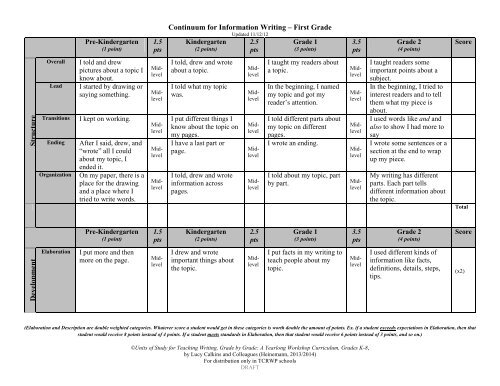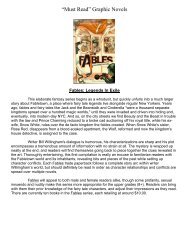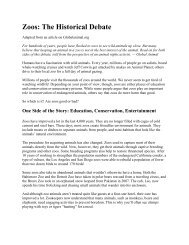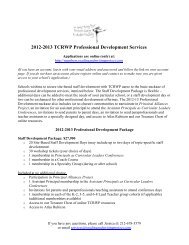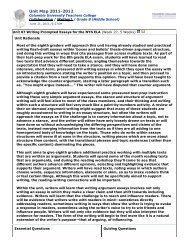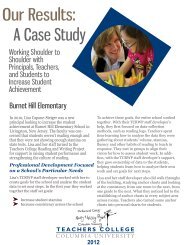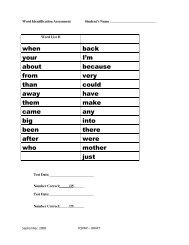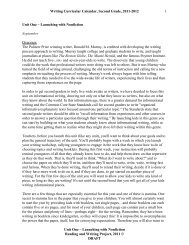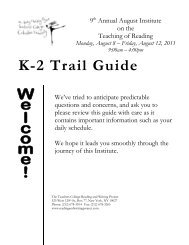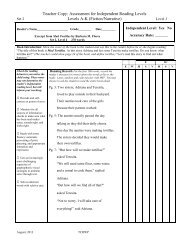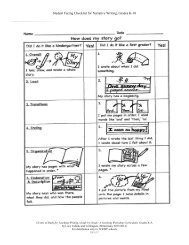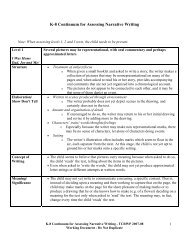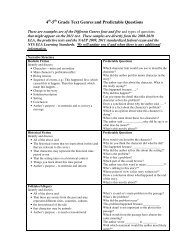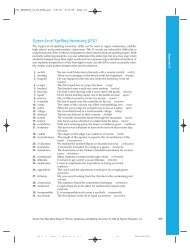Continuum for Information Writing â First Grade S tru cture Develop ...
Continuum for Information Writing â First Grade S tru cture Develop ...
Continuum for Information Writing â First Grade S tru cture Develop ...
Create successful ePaper yourself
Turn your PDF publications into a flip-book with our unique Google optimized e-Paper software.
Pre-Kindergarten<br />
(1 point)<br />
1.5<br />
pts<br />
<strong>Continuum</strong> <strong>for</strong> In<strong>for</strong>mation <strong>Writing</strong> – <strong>First</strong> <strong>Grade</strong><br />
Updated 11/12/12<br />
Kindergarten<br />
(2 points)<br />
2.5<br />
pts<br />
<strong>Grade</strong> 1<br />
(3 points)<br />
3.5<br />
pts<br />
<strong>Grade</strong> 2<br />
(4 points)<br />
Score<br />
S<strong>tru</strong><strong>cture</strong><br />
Overall<br />
Lead<br />
Transitions<br />
Ending<br />
Organization<br />
I told and drew<br />
pi<strong>cture</strong>s about a topic I<br />
know about.<br />
I started by drawing or<br />
saying something.<br />
I kept on working.<br />
After I said, drew, and<br />
“wrote” all I could<br />
about my topic, I<br />
ended it.<br />
On my paper, there is a<br />
place <strong>for</strong> the drawing<br />
and a place where I<br />
tried to write words.<br />
I told, drew and wrote<br />
about a topic.<br />
I told what my topic<br />
was.<br />
I put different things I<br />
know about the topic on<br />
my pages.<br />
I have a last part or<br />
page.<br />
I told, drew and wrote<br />
in<strong>for</strong>mation across<br />
pages.<br />
I taught my readers about<br />
a topic.<br />
In the beginning, I named<br />
my topic and got my<br />
reader’s attention.<br />
I told different parts about<br />
my topic on different<br />
pages.<br />
I wrote an ending.<br />
I told about my topic, part<br />
by part.<br />
Midlevel<br />
Midlevel<br />
Midlevel<br />
Midlevel<br />
Midlevel<br />
Midlevel<br />
Midlevel<br />
Midlevel<br />
Midlevel<br />
Midlevel<br />
Midlevel<br />
Midlevel<br />
Midlevel<br />
Midlevel<br />
Midlevel<br />
I taught readers some<br />
important points about a<br />
subject.<br />
In the beginning, I tried to<br />
interest readers and to tell<br />
them what my piece is<br />
about.<br />
I used words like and and<br />
also to show I had more to<br />
say<br />
I wrote some sentences or a<br />
section at the end to wrap<br />
up my piece.<br />
My writing has different<br />
parts. Each part tells<br />
different in<strong>for</strong>mation about<br />
the topic.<br />
Total<br />
Pre-Kindergarten<br />
(1 point)<br />
1.5<br />
pts<br />
Kindergarten<br />
(2 points)<br />
2.5<br />
pts<br />
<strong>Grade</strong> 1<br />
(3 points)<br />
3.5<br />
pts<br />
<strong>Grade</strong> 2<br />
(4 points)<br />
Score<br />
<strong>Develop</strong>ment<br />
Elaboration<br />
I put more and then<br />
more on the page.<br />
I drew and wrote<br />
important things about<br />
the topic.<br />
I put facts in my writing to<br />
teach people about my<br />
topic.<br />
Midlevel<br />
Midlevel<br />
Midlevel<br />
I used different kinds of<br />
in<strong>for</strong>mation like facts,<br />
definitions, details, steps,<br />
tips.<br />
(x2)<br />
(Elaboration and Description are double weighted categories. Whatever score a student would get in these categories is worth double the amount of points. Ex. if a student exceeds expectations in Elaboration, then that<br />
student would receive 8 points instead of 4 points. If a student meets standards in Elaboration, then that student would receive 6 points instead of 3 points, and so on.)<br />
©Units of Study <strong>for</strong> Teaching <strong>Writing</strong>, <strong>Grade</strong> by <strong>Grade</strong>: A Yearlong Workshop Curriculum, <strong>Grade</strong>s K-8,<br />
by Lucy Calkins and Colleagues (Heinemann, 2013/2014)<br />
For distribution only in TCRWP schools<br />
DRAFT
Description<br />
Pre-Kindergarten<br />
(1 point)<br />
I said, drew, and<br />
“wrote” things I know<br />
about the topic.<br />
1.5<br />
pts<br />
<strong>Continuum</strong> <strong>for</strong> In<strong>for</strong>mation <strong>Writing</strong> – <strong>First</strong> <strong>Grade</strong><br />
Updated 11/12/12<br />
Kindergarten<br />
(2 points)<br />
I told, drew, and wrote<br />
some details about the<br />
topic.<br />
2.5<br />
pts<br />
<strong>Grade</strong> 1<br />
(3 points)<br />
I used labels and words to<br />
give facts.<br />
3.5<br />
pts<br />
Midlevel<br />
Midlevel<br />
Midlevel<br />
<strong>Grade</strong> 2<br />
(4 points)<br />
I tried to include the words<br />
that show I’m an expert on<br />
the topic.<br />
Score<br />
(x2)<br />
Total<br />
Spelling<br />
Pre-Kindergarten<br />
(1 point)<br />
I can read my pi<strong>cture</strong>s<br />
and some of my<br />
words.<br />
1.5<br />
pts<br />
Kindergarten<br />
(2 points)<br />
I can read my writing.<br />
2.5<br />
pts<br />
<strong>Grade</strong> 1<br />
(3 points)<br />
I used all I know about<br />
words and chunks (“at,”<br />
“op,” “it”…) to help me<br />
spell.<br />
3.5<br />
pts<br />
Midlevel<br />
Midlevel<br />
Midlevel<br />
<strong>Grade</strong> 2<br />
(4 points)<br />
To spell a word, I used<br />
what I know about spelling<br />
patterns (“tion,” “er,” “ly”,<br />
etc.)<br />
Score<br />
Language Conventions<br />
Punctuation<br />
I tried to make words.<br />
I can label pi<strong>cture</strong>s.<br />
I can write my name.<br />
I wrote a letter <strong>for</strong> the<br />
sounds I hear.<br />
I used the Word Wall to<br />
help me spell.<br />
I put spaces between<br />
words.<br />
I used lower case letters<br />
unless capitals were<br />
needed.<br />
I spelled the Word Wall<br />
Words right and used the<br />
Word Wall to help me<br />
spell other words.<br />
I ended sentences with<br />
punctuation.<br />
I used a capital letter <strong>for</strong><br />
names.<br />
Midlevel<br />
Midlevel<br />
Midlevel<br />
I spelled all of the Word<br />
Wall words correctly and<br />
used the Word Wall to help<br />
me figure out how to spell<br />
other words.<br />
I used quotation marks to<br />
show what people said.<br />
When I used words like<br />
can’t and don’t, I put in the<br />
apostrophe.<br />
I wrote capital letters to<br />
start every sentence.<br />
I used commas in dates<br />
and lists<br />
Total<br />
Teachers, when this is totally finished, each category will refer to “the writer” rather than “I”. We are giving out these assessments so they can be used immediately, after giving the on demands, and<br />
they can be used with kids <strong>for</strong> self-assessment and setting goals. We have created these Continuua so you will have your own place to pull together scores of student work.<br />
(Elaboration and Description are double weighted categories. Whatever score a student would get in these categories is worth double the amount of points. Ex. if a student exceeds expectations in Elaboration, then that<br />
student would receive 8 points instead of 4 points. If a student meets standards in Elaboration, then that student would receive 6 points instead of 3 points, and so on.)<br />
©Units of Study <strong>for</strong> Teaching <strong>Writing</strong>, <strong>Grade</strong> by <strong>Grade</strong>: A Yearlong Workshop Curriculum, <strong>Grade</strong>s K-8,<br />
by Lucy Calkins and Colleagues (Heinemann, 2013/2014)<br />
For distribution only in TCRWP schools<br />
DRAFT
<strong>Continuum</strong> <strong>for</strong> In<strong>for</strong>mation <strong>Writing</strong> – <strong>First</strong> <strong>Grade</strong><br />
Updated 11/12/12<br />
Scoring Guide:<br />
In each row, circle the descriptor in the column that matches the student work. Scores in the categories of Elaboration and Description are worth double the point<br />
value (2, 3, 4, 5, 6, 7, or 8 instead of 1, 1.5, 2, 2.5, 3, 3.5, or 4).<br />
Total the number of points, and track students’ progress by seeing when the total points increase.<br />
Total score: ________<br />
If you want to translate this score into a grade, you can use the provided table to score each student on a scale from 0 – 4.<br />
Number of Points<br />
Scaled Score<br />
1-11 1<br />
11.5-16.5 1.5<br />
17-22 2<br />
22.5-27.5 2.5<br />
28-33 3<br />
33.5-38.5 3.5<br />
39-44 4<br />
(Elaboration and Description are double weighted categories. Whatever score a student would get in these categories is worth double the amount of points. Ex. if a student exceeds expectations in Elaboration, then that<br />
student would receive 8 points instead of 4 points. If a student meets standards in Elaboration, then that student would receive 6 points instead of 3 points, and so on.)<br />
©Units of Study <strong>for</strong> Teaching <strong>Writing</strong>, <strong>Grade</strong> by <strong>Grade</strong>: A Yearlong Workshop Curriculum, <strong>Grade</strong>s K-8,<br />
by Lucy Calkins and Colleagues (Heinemann, 2013/2014)<br />
For distribution only in TCRWP schools<br />
DRAFT


